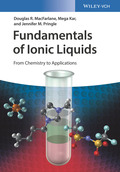Fundamentals of Ionic Liquids
From Chemistry to Applications

1. Auflage Oktober 2017
X, 248 Seiten, Hardcover
5 Abbildungen (5 Farbabbildungen)
Praktikerbuch
Kurzbeschreibung
Written by experts in both research and academia, this practical guide shows readers how to efficiently work with ionic liquids. It describes their various types and the different techniques used to synthesize them, as well as their properties and some of the measurement methods.
Jetzt kaufen
Preis: 99,90 €
Preis inkl. MwSt, zzgl. Versand
Euro-Preise für Wiley-VCH- und Ernst & Sohn-Titel sind nur für Deutschland gültig. In EU-Ländern gilt die lokale Mehrwertsteuer. Portokosten werden berechnet.
Written by experts who have been part of this field since its beginnings in both research and academia, this textbook introduces readers to this evolving topic and the broad range of applications that are being explored.
The book begins by examining what it is that defines ionic liquids and what sets them apart from other materials. Chapters describe the various types of ionic liquids and the different techniques used to synthesize them, as well as their properties and some of the methods used in their measurement. Further chapters delve into synthetic and electrochemical applications and their broad use as "Green" solvents. Final chapters examine important applications in a wide variety of contexts, including such devices as solar cells and batteries, electrochemistry, and biotechnology.
The result is a must-have resource for any researcher beginning to work in this growing field, including senior undergraduates and postgraduates.
Innovation Through New Materials
What Makes an Ionic Liquid, an "Ionic" Liquid?
What Can These Unique Materials Do - A Brief Overview
How Do We Go about Understanding Ionic Liquids?
STRUCTURE OF IONIC LIQUID FORMING IONS
Crystal Formation and How to Avoid It (Thermodynamics of Solids, Liquids and Melting)
Avoiding Efficient Packing of Ions - Bulky, Rigid and Low Symmetry Ions
Electrostatic Forces and How to Minimize Them (Shielding and Charge Delocalization)
Other Types of Ions (Metal-Based Ions, Polymeric Ions etc.)
Protic Ionic Liquids
Further Reading
STRUCTURE OF IONIC LIQUIDS
Introduction - Evidence for Structuring in Ionic Liquids at Various Length Scales; Ionicity
Experimental Probes of Structure
Simulation Approaches to Understanding Structure
Further Reading
SYNTHESIS OF IONIC LIQUIDS
Introduction
Approaches to Synthesis (Quaternisation/Alkylation, Metathesis, Anion Exchange, Proton Exchange, etc.)
Purification: Challenges and Methods (Halide Impurities, Proton Impurities, etc.; Re-Crystallization, Micro-Filtration, Anion-Exchange Resin, etc.)
Structure and Purity Analysis (NMR, MS, etc.)
Further Reading
PHYSICAL AND THERMAL PROPERTIES
Introduction - What Properties are Important?
Thermal Properties (Melting, Liquid crystal Formation, Decomposition)
Transport Properties and their Inter-Relationships (Viscosity, Conductivity, Diffusion, Walden Plot, etc.)
Properties of Ionic Liquid Mixtures
Further Reading
SOLVENT PROPERTIES AND SYNTHETIC APPLICATIONS OF IONIC LIQUIDS
Introduction - Solvency, Intermolecular Forces and Polarisability
Synthetic Chemistry in Ionic Liquids - Selected Examples
Liquid-Liquid Phase Equilibrium (Solvent Extraction/Separation, Water/Ionic Liquid Mixing and De-Mixing)
Biomass Dissolution and Processing (Cellulose, Keratin, etc.)
Gas Solubility and Applications (CO2, SO2, O2, etc.)
Further Reading
ELECTROCHEMISTRY OF, AND IN, IONIC LIQUIDS
Introduction
Cyclic Voltammetry (Reference Electrodes, Electrochemical Window, etc.)
Electro-Deposition of Metals
Electrosynthesis in Ionic Liquids
Further Reading
DEVICE APPLICATIONS
Introduction
Batteries (Li-Ion, Metal-Air, etc.)
Fuel Cells
Dye Sensitized Solar Cells
Supercapacitors
Actuators
Further Reading
BIOTECHNOLOGY APPLICATIONS
Biocompatible Ionic Liquids
Ionic Liquids from Active Pharmaceutical Ingredients
Biomolecule Stabilisation (Proteins, DNA, RNA)
Further Reading
CONCLUSIONS/FUTURE DIRECTIONS
APPENDIX
Glossary of Ions, Their Structure and Nomenclature (including acronyms)
Anions
Cations
A/Prof Jennifer Pringle is a Senior Research Fellow in the Institute for Frontier Materials at Deakin University, and a chief investigator in the ARC Centre of Excellence for Electromaterials Science. She received her degree and PhD at The University of Edinburgh in Scotland before moving to Monash University in Melbourne, Australia in 2002. From 2008-2012 she held an ARC QEII Fellowship, investigating the use of ionic electrolytes for dye-sensitized solar cells. A/Prof Pringle moved to Deakin University, Melbourne in 2013. There she leads research into the development and use of ionic electrolytes for applications including thermal energy harvesting and solid state lithium batteries.
Dr. Mega Kar is a Research Fellow in the Monash Ionic Liquids group. She completed her undergraduate degree with honours at The University of Melbourne in 2008. She then went onto study her doctor of philosophy (PhD) at Monash University in Professor Douglas MacFarlane?s group, which focused on designing novel room-temperature alkoxy-ammonium based ionic liquids as electrolytes for reversible zinc electrochemistry, working towards a rechargeable metal-air battery for energy storage applications. Dr. Kar is currently a Research Fellow at Monash University, lecturing and specializing in IL synthesis and electrochemistry, working on electrodeposition and metal batteries.


